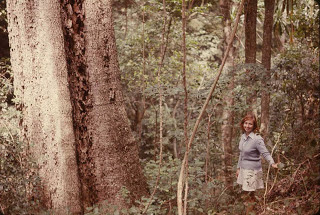Many years ago, from the early 70's to the 80's, my wife and I worked in Africa. While passing through London, an ichthyologist at the British Museum, Humphry Greenwood, asked us to look in northeast Kenya for a species of killifish whose status was poorly known. We had some experience with keeping killifish thanks to a friend in New Jersey, aquarist and author Rosario LaCorte. We collected fish over several years as we traveled around for our research, and back in the states kept a few pairs of related species from all over Africa.
A species of Nothobranchius collected by us from south of Lamu, Kenya
Many of these killifish live in temporary pools, and the adults die when the water dries up. The next generation rests as eggs in the mud, and hatch when the rains return. This gives them the name "annual fishes". Above are some annual killies from elephant pans in coastal Kenya, north of Malindi.
Susan taking photographs in Kenya National Museum.
Industrialization of parts of Africa, and the clearing of forests for their hardwoods and for agriculture, have sent many forest species to the verge of extinction. For example, this is, or was, the Karura Forest near Nairobi in Kenya in 1972.
Susan in Karura Forest, 1972
Today the old trees in many Kenya forests are gone, felled for hardwoods. Reforestation efforts are under way, but it will take about 200 years to restore the forest. By that time, many animal species that depended on the forests will become extinct. Kenya now faces terrible droughts, because they have removed the large trees that tap the groundwater and return moisture to the atmosphere above them.
Keeping a bit of Africa at home.
Lately I've started to keep a few killifish species again. I have a light teaching schedule as retirement looms (2015 update, I retired on January 1st). I've rejoined a local aquarium club that preserves them, selected a few species to keep, and filled a small room in the basement with aquaria. There is a lot to relearn, and keeping these colorful fish is very labor intensive. Just the thing for an old professor.
At present we keep fish from West Africa: Aphyosemion australe "the golden lyretail" from Gabon, Fundulosoma gardneri from Makurdi in Nigeria, Aplocheilus (Epiplatys) dageti, and Aphyosemion primagenium. The first three are commonly kept, the latter is my preservation project.
A trip today to the fish room resulted in pictures of the first two species.
Above is my photo of a male Fundulosoma gardeneri from Makurdi, Nigeria. He is looking at his reflection.
and here our breeding pair of Aphyosemion australe, the xanthic aquarium form. The female in the foreground is less colorful.
In each tank there are a few floating plants, a box filter with gravel, and a yarn mop for collecting eggs.
In addition to killifish, we also propagate a varying assortment of characins, gouramis and danios.
Here is a rough video of the fish we keep.
Notice: All of these posts and photos are copyrighted, with all rights reserved. Hundreds of friends and relations have seen the Africa photos and heard the stories, and read published versions of them on other sites.






No comments:
Post a Comment